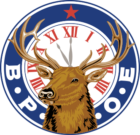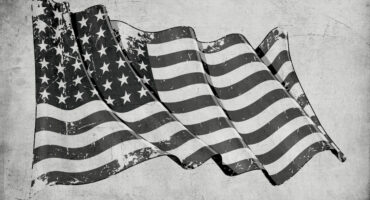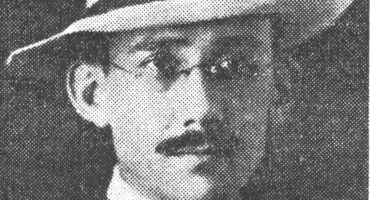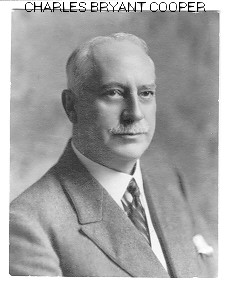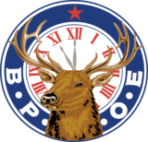Hawaii Entertains at San Francisco Elks Lodge Opening
Hawaii Entertains at San Francisco Elks Lodge Opening
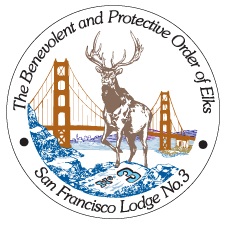
San Francisco July 1925:
Newspapers report Santa Barbara’s efforts to rebuild after a June earthquake and plans for the state’s Diamond Jubilee. The stock market climbs; only a few observers caution the rise can not go on forever. The Dayton, Tenn., trial of high school science teacher John Scopes, accused of teaching evolution, holds the front page for weeks. In federal court, those who lost fortunes in the World War alien property seizure of Hawaii’s Hackfeld Co. (divided up and sold to become American Factors and Liberty House) sue for recompense.
Hawaii Elks, visiting the city before the Portland Grand Lodge meeting, attend Lodge 3’s July 10 meeting in new, sumptuous quarters on Post St. One attraction of a west coast visit for Hawaii folks was seeing films before they reached Hawaii. Brother Elks thinking to share a flick could chose from Douglas Fairbanks in Thief of Bagdad, Arthur Conan Doyle’s story of a modern land where dinosaurs still roam The Lost World or DeMille’s The Ten Commandments,. Entertainment news hyped the pairing of Lost World and Scopes’ “Monkey Trial.” Hawaii Elks may have suggested the new comedy, Grounds for Divorce screening at the California theater a few blocks from Lodge 3. Doubtlessly San Francisco Elks said, “No thanks. We’ve seen the other film.” 616 Elks refocusing on the ad saw a familiar title and name: A Trip to the Hawaiian Islands, William F. Aldrich.
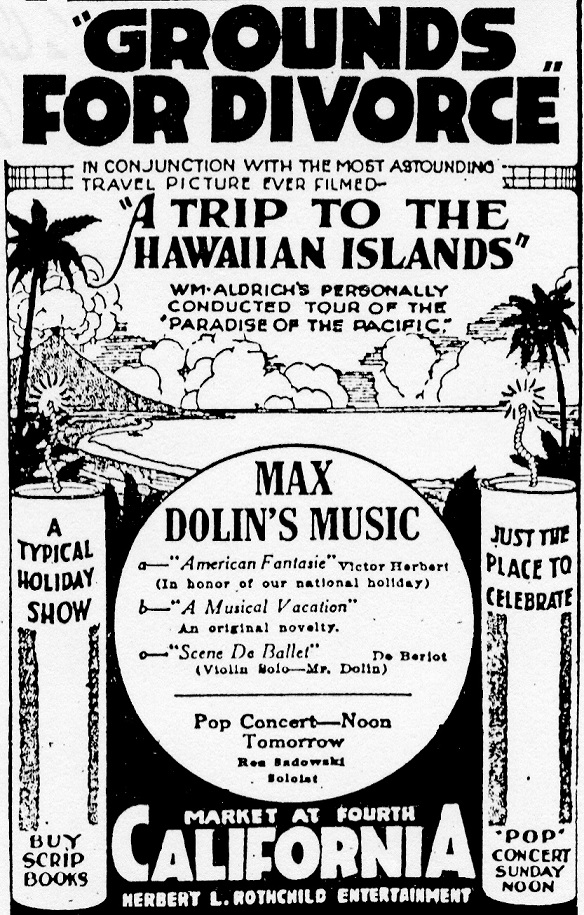
In May 1925 Lodge 3 had several “first” nights in their new building. One members’ night included showing Aldrich’s film with performance and encores by singers and dancers. The Lodge arranged a second show to which Elk wives were invited the following week.
Word spread in theater circles and A Trip to the Hawaiian Islands opened at the prestigious California theater July 4th. Moving to Oakland’s Franklin theater later in July, ads touted: “Tremendous Sensation; Direct from stupendous success at San Francisco’s California Theater.”
Bill Aldrich zipped in and out of Hawaii to film travelogues, gather entertainers, and then return to the mainland to tour the results. He experimented with short films including 1918’s Poi or Bust, the Sonny Cunha comedy. In mid-May 1918, Aldrich exhausted the Hawaii audience for his self-produced films and his temporary Airdome theater at Nuuanu and Pauahi Sts. withered away.
Aldrich was a favorite of Hawaii tourism business groups such as the Ad Club. He traveled across the mainland to theaters small and large showing his Hawaii travelogue supported by live entertainers, Aldrich’s Imperial Hawaiians. His shows advertised Hawaii, correcting common erroneous beliefs (No, there is not an active volcano in Honolulu). In a letter to the Advertiser, Aldrich boasted his film and troupe reached 1 mil. people in a few months. He touted 400,000 viewers in greater Chicago.
Of the 1925 show self-promoter Aldrich bragged: “the show I brought over promises to be one of the outstanding publicity stunts of the year for the islands.” Aldrich did live narration, complimented by singer/dancers Frank and Helen Andrade, James Kualii, and Joseph and Lucy Lopes.
Wife Peggy Aldrich often acted as road manager. In 1926 Bill and Peggy each operated a company of singer-dancers plus the now hour long film. She returned to Oahu to recruit “high grade Hawaiian musicians” for a third group. The coming season would feature after each performance a drawing for a free trip to Hawaii. In 1930, Aldrich left the road – in a way. He created a Hawaiian village at Atlantic City “on the famous steel pier, a few feet from the Boardwalk.” Aldrich came home to recruit musicians and divers. Bill wanted “a chap who can take a header from 100 ft. up, turn a couple of somersaults, and land safely and gracefully in the water.” The Ad Club, including Lodge 616 Elks members, got behind this living advertisement for island tourism by holding a “shower” for Aldrich. Ad Club members were urged to bring fish nets, calabashes, surfboards, poi pounders, fans, mats and anything else available to help Bill with an ‘Extreme Makeover: the village’. The 20 member troupe traveled California to New Jersey in just 7 days living in a Mack bus converted to a rolling motor home.
Tourism groups wanted a presence at Atlantic City: “a city of tourists…filled year round with just the sort of people our Hawaii advertising campaign should reach.” The Hawaii Promotion Committee had a presence on the Steel Pier as early as 1910 – singers, dancers, divers, even fresh pineapple. One Hawaiian dance troupe performed at an east coast Elks’ event, before being banned by pier management as ‘objectionable’(!). Adventurous Hawaiians kept diving off the Steel Pier. Among many: 1930s – dancer Harriet Keonaonalaulani Purdy Kauaihilo, aka Hawaiian Human Cannonball; 1940s – composer, musician John Kamano dove 115ft, cigar in mouth, holding an umbrella!
Descriptions of Aldrich meet the central casting image of a Hollywood mogul: “If things go right, Bill chews more cigars and wears the biggest of smiles. When things are not ‘breaking’ right there is no cigar in Bill’s mouth and he’s a grim looking individual.” Reportedly, the San Francisco Elks Lodge 3 opening day destroyed 20 cigars!
Anita Manning, Lodge Historian
References:
616 Minutes 1925 Apr 17
Advertiser 1918 May 12; 1925 May 27; 2002 Nov 9
Aloha Elk 2006 Feb “Sonny Cunha – Movie Star Elk”
Hawaii Newspaper Agency Morgue
Paradise of the Pacific 1910 23:5; 1916 29:11
San Francisco Chronicle 1925 Jul 4, 10
Star Bulletin 1925 May 26, Jul 11, 13; 1926 Sep 4; 1930 Apr 4, 5
Todaro, T. 1974 Golden Yrs of Hawn entertainment.

